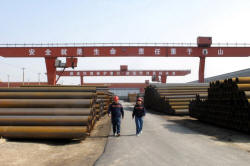China's June industrial profit growth eases as trade
risks rise
 Send a link to a friend
Send a link to a friend
 [July 27, 2018]
By Yawen Chen and Elias Glenn [July 27, 2018]
By Yawen Chen and Elias Glenn
BEIJING (Reuters) - Profit growth for
China's industrial firms eased in June from the previous month, as
factory production slowed amid rising trade frictions with the United
States and Beijing's ongoing efforts to cut pollution and debt.
Analysts say profits could be further crimped in the second half of the
year as trade woes deepen, adding more pressure on growth in the world's
second-largest economy.
Industrial profits rose 20 percent to 658.29 billion yuan ($96.7
billion) in June, National Bureau of Statistics (NBS) data showed on
Friday, compared with a 21.1 percent rise in May.
NBS said in a statement on the data that rising prices had cushioned
firms' profits even as industrial production slowed in June, but it did
not provide separate reasons for the slower profit growth.
Lisheng Wang, an economist at Nomura in Hong Kong, said it was hard to
tell what impact the trade tensions had on industrial firms in June, but
economic headwinds were growing.

"In the second half of this year there could be a more visible slowdown
in export growth in China, which could put some downside pressure on
profits," Wang said.
Steel, building materials and oil extraction sectors were key drivers
behind profit growth in the first half of the year, it added. But profit
growth in textile, non-ferrous metal smelting and processing, and
telecommunications and electronic equipment manufacturing profits fell
during the same period from a year earlier.
For the first half of the year, industrial firms' profits grew 17.2
percent from a year earlier to 3.39 trillion yuan, accelerating from a
16.5 percent rise for January-May.
The data covers firms with annual sales of at least 20 million yuan.
China's economic growth slowed in the April-June period from the
previous quarter while June's industrial output growth slumped to a
four-year low, raising concerns about the outlook amid growing signs of
stress.
The government's campaign to cut debt and emissions have driven up
borrowing costs and curbed production for some key industries, while
threats of further tariffs on Chinese goods from Washington add to the
headwinds for the second quarter even as Beijing insists economic
fundamentals are sound.
[to top of second column] |

Workers walk past steel pipes at a steel mill in Cangzhou, Hebei
province, China March 19, 2018. Picture taken March 19, 2018.
REUTERS/Muyu Xu/File Photo

The central bank in June cut bank reserve requirements for the third time this
year and has pumped more money into financial markets. Policymakers have so far
ruled out the odds of a major stimulus package but have vowed to take necessary
fiscal and monetary steps to support growth while urging banks to ensure
adequate liquidity for smaller firms.
Nomura's Wang said despite some expected fiscal stimulus from the government to
cushion the economy, he saw risks in the second half of the year due to
weakening domestic demand, a slowing property market and China-U.S. trade
tensions.
"We still maintain our call that economic growth will slow visibly to 6.4
percent in the third quarter," Wang said.
The country's industrial firms have benefited over the past two years from hot
property and infrastructure construction markets, which boosted demand for
building materials such as steel bars and cement. Price growth of new homes
accelerated to a near two-year high in June, on monthly terms, suggesting
continued momentum despite recent government curbs.
However, there are challenges for producers with growth in fixed-asset
investment hitting a record low in the first half of this year amid a war
against pollution. Raw materials cost also rose at a faster clip than the
producer price index in June, suggesting possible margin pressures.
PROFITS DECLINE
Despite the strong headline growth figure, the 658.29 billion yuan in total
profits earned by China's large industrial firms was 9.5 percent lower than the
nominal 727.8 billion yuan reported last June.

The large and widening divergence in reported and implied profit growth has
raised questions about the data.
The statistics bureau in June has addressed the issue three times within the
last month, attributing the difference to changes in the sample size and
statistical methodology. It said that fewer firms met the requirements to be
included.
(Editing by Sam Holmes and Jacqueline Wong)
[© 2018 Thomson Reuters. All rights
reserved.] Copyright 2018 Reuters. All rights reserved. This material may not be published,
broadcast, rewritten or redistributed.
Thompson Reuters is solely responsible for this content. |